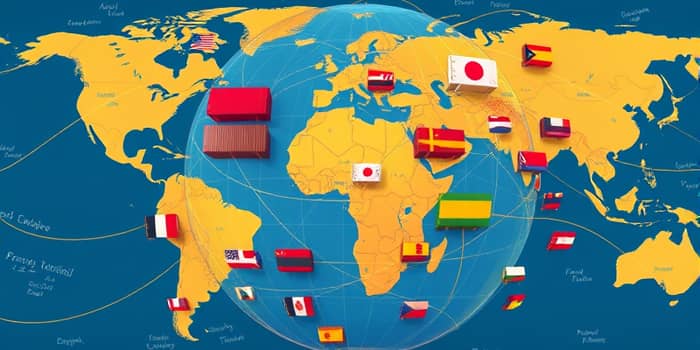
Over the past year, global commerce has achieved new heights as nations work to forge pathways for growth and cooperation. In an era defined by rapid technological advances and geopolitical uncertainties, understanding the mechanisms that drive international trade is more essential than ever. This article delves into how recent agreements and tariff measures are shaping markets and influencing the distribution of economic opportunity worldwide.
By examining the landscape of 2024–2025, stakeholders can glean insights into emerging trends, challenges, and opportunities that define the current state of trade. From groundbreaking bilateral pacts to evolving tariff structures, each development carries implications for businesses, policymakers, and consumers alike. Engaging with these dynamics requires both strategic foresight and practical adaptability.
The global trade network experienced record-breaking global trade growth in 2024, with the total value of cross-border transactions reaching $33 trillion. This 3.7% increase from the previous year was driven largely by the expansion of service sectors, which outpaced goods in value added. While this growth underscores the resilience of international exchange, it also highlights an unprecedented economic integration challenges posed by shifting geopolitical tides.
Despite the upward trajectory, the outlook for 2025 remains cautious. Geopolitical tensions have the potential to reverse gains, while new trade agreements offer both promise and complexity. Stakeholders must balance the momentum of rising trade volumes with the need to navigate an intricate web of rules, regulations, and diplomatic considerations.
Tariffs continue to serve as critical levers in trade policy, offering protective measures for domestic industries and generating revenue for governments. However, they can also introduce distortions that impede market access and discourage value-added production in emerging economies. Across sectors, tariff regimes vary significantly:
High tariffs on finished goods, a practice known as tariff escalation, can limit industrialization prospects in developing regions. Policymakers aiming to foster economic diversification are increasingly aware of the need for complex tariff landscapes and regulations that support technological transfer and local value creation.
In May 2025, the United States and China concluded a landmark agreement to roll back retaliatory tariffs while maintaining a baseline duty. Although reporting on “lowering tariffs by 115%” appears anomalous, the true impact lies in the recalibration of trade tensions and the renewed commitment to trade relations that underpins broader market stability.
Shortly thereafter, preliminary U.S. deals with several key partners addressed strategic resources. China agreed to ease restrictions on rare earth (critical for emerging technologies), while the U.S. lifted select export controls. These moves signal a gradual shift toward cooperation in areas previously marked by contention.
Meanwhile, the U.S. postponed reciprocal tariffs on a range of countries—including Norway, South Korea, and Switzerland—providing temporary relief for supply chains that span multiple continents. The delayed implementation of duties, set to take effect in July 2025, underscores the delicate balance between enforcement and engagement in modern trade diplomacy.
Free Trade Agreements (FTAs) continue to reshape export patterns, though their effects are often more nuanced than headline figures suggest. While total exports do not always surge, firms frequently reallocate shipments toward newly tariff-free markets. In Central America and Southeast Asia, export diversification has become a strategic imperative, altering the competitive landscape in agriculture, manufacturing, and services.
These agreements illustrate that FTAs are not static instruments but dynamic frameworks that evolve with market conditions and political priorities. Businesses that monitor and adapt to these shifts can capitalize on new opportunities and mitigate risks associated with reallocation.
Beyond tariffs and quotas, international standards bodies (such as the ISO and WTO’s TBT Committee) play a vital role in harmonizing technical regulations. Achieving consensus on safety, environmental, and quality benchmarks fosters trust among trading partners and reduces non-tariff barriers.
Effective policy design also depends on holistic stakeholder engagement and consensus-building. Governments, industry associations, and civil society must collaborate to ensure that trade agreements are not only economically viable but also socially responsible. In practice, this involves transparent consultation processes and ongoing dialogue to align regulations with broader development objectives.
Such measures help promote sustainable diversification and industrialization pathways in regions that have historically been locked into low-value commodity markets.
As we look ahead, several key factors will shape the trajectory of global trade. Geopolitical risks—from supply chain disruptions to resource nationalism—remain high on the agenda. Meanwhile, emerging technologies in logistics, digital services, and clean energy are rewriting the rules of market competition.
To thrive in this environment, businesses and policymakers should focus on building resilient supply chains and competitive advantage by adopting a combination of strategic approaches:
By aligning trade strategies with innovations in technology and governance, stakeholders can transform uncertainty into opportunity. Embracing flexibility and foresight will enable businesses to navigate the evolving landscape with confidence and creativity.
Ultimately, understanding the interplay between international agreements, tariffs, and market dynamics is essential for seizing the growth potential that lies ahead. As nations negotiate new pacts and refine existing frameworks, those who stay informed and proactive will be best positioned to contribute to—and benefit from—the continued expansion of global trade.
References













